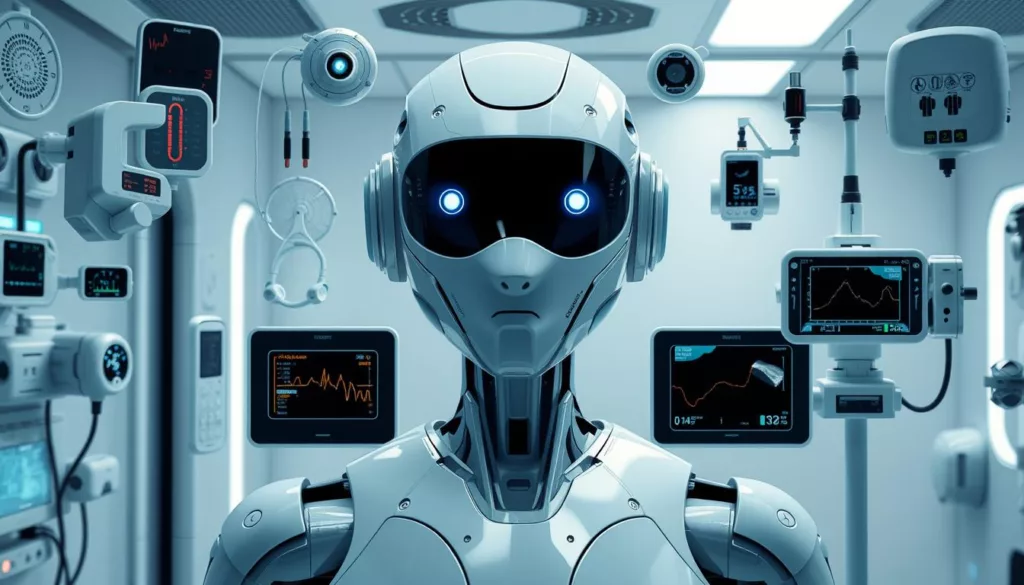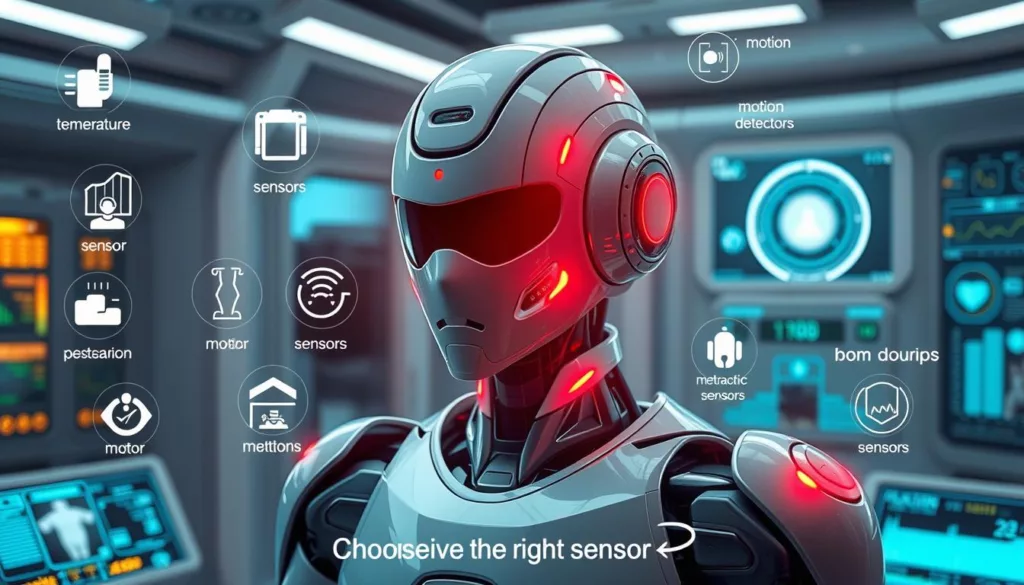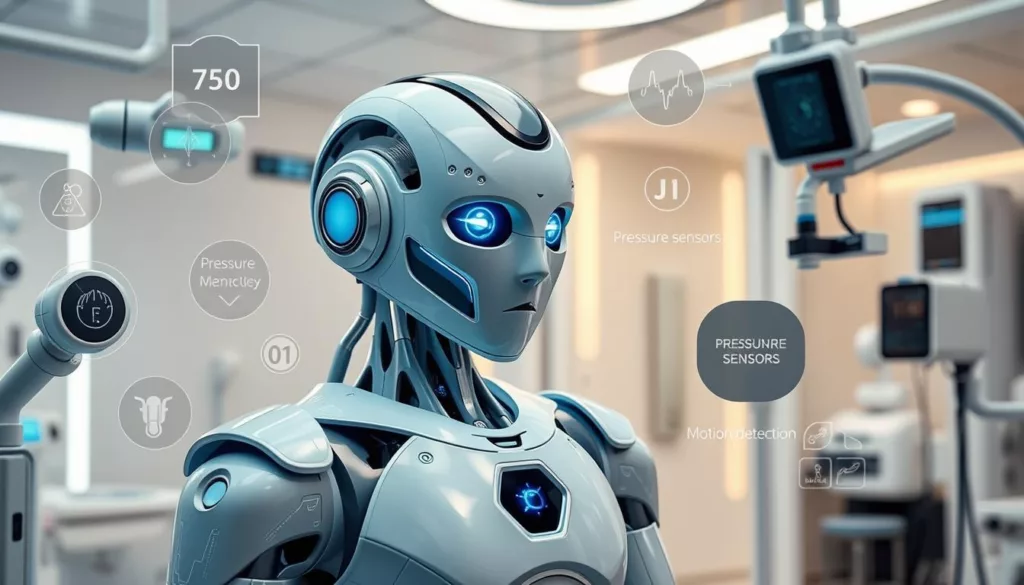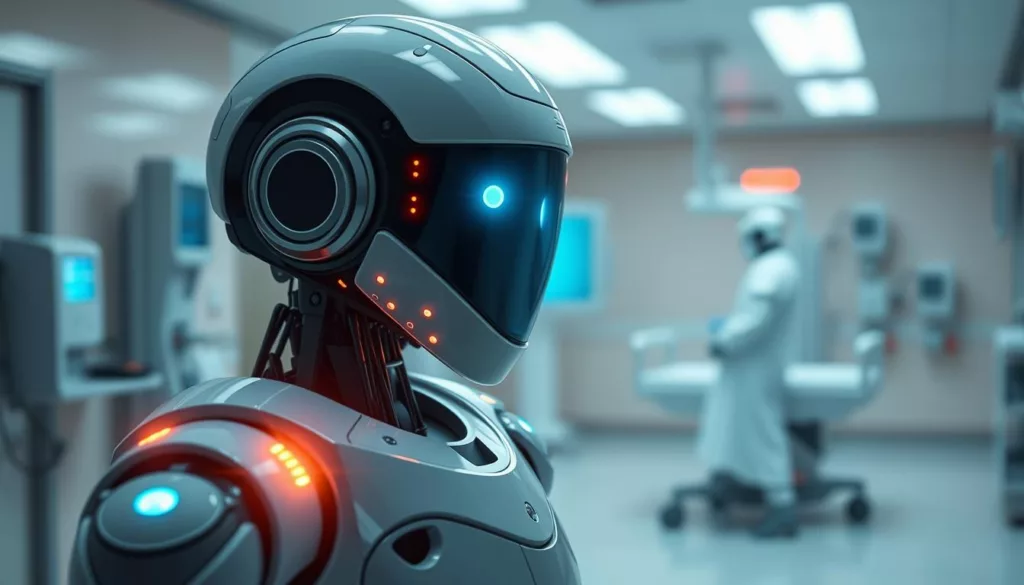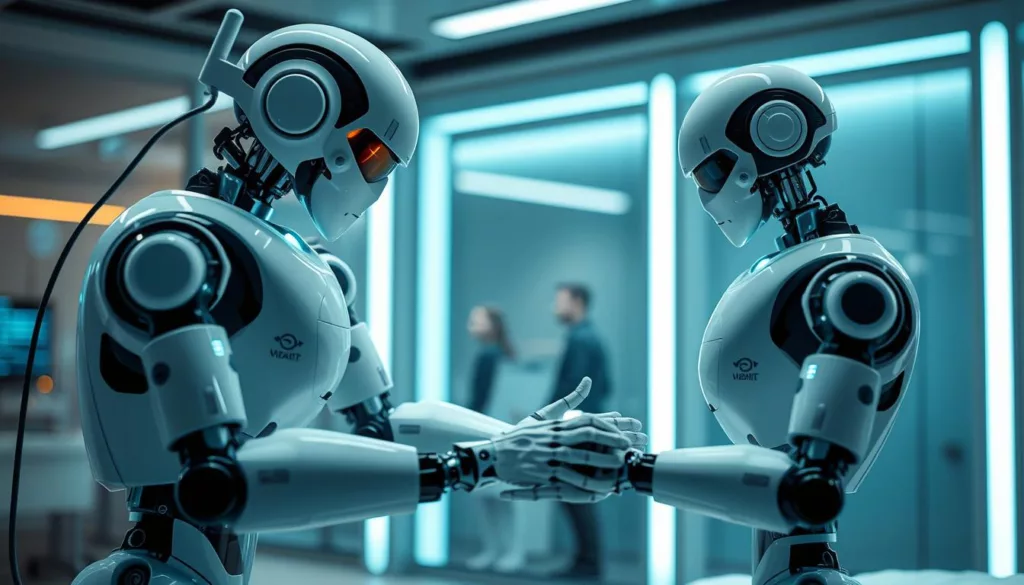In today’s fast-changing healthcare world, picking the right sensor for healthcare robots is key. These robots help a lot in patient care. At XJCSENSOR, we offer customizable sensors for medical robots. We help engineers and healthcare pros make smart choices.
This guide will look at the different sensors and their uses in healthcare robots.
Key Takeaways
- Understanding sensor functionality is vital for healthcare robotics.
- Different sensors have unique roles in patient care and diagnostics.
- Think about specific healthcare needs when picking sensors.
- Customizable sensor solutions boost medical robot abilities.
- Getting expert advice helps make better choices.
Understanding the Role of Sensors in Healthcare Robotics
Sensors are key to making medical robots work well. They help robots collect and understand important data from their environment and patients. This is vital for tasks like diagnosing, monitoring, and interacting with patients.
The role of sensors in healthcare robotics is huge. They turn physical and environmental signals into useful information. This helps robots make better decisions, leading to safer and more efficient care in hospitals and clinics.
| Sensor Type | Function | Healthcare Robotics Applications |
|---|---|---|
| Temperature Sensors | Monitor body temperature | Patient monitoring systems |
| Pressure Sensors | Measure pressure levels | Surgical robots, rehabilitation devices |
| Motion Sensors | Detect movement | Assisted living robots |
| Biosensors | Analyze biochemical signals | Diagnostic tools, health monitoring |
At XJCSENSOR, we know how important top-notch sensors are for healthcare robots. We use the latest sensing tech to boost efficiency and safety in medical settings. Our goal is to help make healthcare better for everyone.
Types of Sensors Used in Healthcare Robots
Healthcare robots are getting smarter, thanks to different sensor technologies. They use proximity sensors, force sensors, vision sensors, and biosensors. Each type plays a key role in making these robots work well in medical settings.
Let’s look at what each sensor does:
| Sensor Type | Function | Applications |
|---|---|---|
| Proximity Sensors | Detect nearby objects without physical contact. | Essential for navigation and obstacle avoidance. |
| Force Sensors | Measure applied force to prevent damage during procedures. | Critical in surgical applications for delicate manipulations. |
| Vision Sensors | Capture visual data for diagnostics and navigation. | Utilized in image analysis and robotic guidance. |
| Biosensors | Monitor biological signals in real time. | Used for health monitoring and patient assessments. |
Knowing about these sensors helps engineers and leaders pick the right ones for healthcare needs.
How to Choose the Right Sensor for Healthcare Robots
In the world of healthcare robotics, picking the right sensor is key. It’s important to evaluate different factors carefully. This ensures the best sensor is chosen for healthcare robots.
Key Considerations for Selection
When picking sensors, several important things need to be looked at. These are essential for healthcare settings:
- Functionality: The sensor must do its job well, like monitoring patients accurately.
- Compatibility: It should work well with the robot’s system.
- Accuracy and Precision: High-quality data is critical for patient safety and treatment.
Matching Sensors to Specific Healthcare Needs
Choosing the right sensor means knowing the specific needs and settings. Think about these points:
- Application Requirements: Make sure the sensor works well in the environment it will be used in.
- Patient Interaction: The sensor should not harm patient comfort or safety.
At XJCSENSOR, we help clients pick the best sensors for their needs. This includes torque sensors that improve robot performance.
| Consideration | Importance | Best Medical Sensors |
|---|---|---|
| Functionality | Crucial for achieving desired outcomes | Pressure Sensors |
| Compatibility | Ensures seamless integration | Torque Sensors |
| Accuracy | Essential for reliable data | Force Sensors |
Medical Robotics Sensors Explained
Medical robotics sensors are key in today’s healthcare. They use advanced tech to help with many tasks. These sensors improve patient care and make healthcare systems work better.
They let healthcare robots do complex tasks. This ensures they work well and safely in hospitals.
It’s important to know about the sensor types in medical robotics. Each sensor has special abilities for different healthcare needs. Some main types are:
- Proximity sensors: These find objects nearby, important for patient care.
- Force sensors: They measure how much force is used, useful in surgery or rehab.
- Vision sensors: These help recognize images and give data for quick diagnosis.
- Biosensors: They watch biological signs like heart rate and temperature.
At XJCSENSOR, we focus on healthcare sensor technologies. We aim to create solutions that fit changing healthcare needs. By using different sensors, we help doctors and nurses improve care and make work easier.
| Sensor Type | Functionality | Application |
|---|---|---|
| Proximity Sensors | Detects nearby objects | Patient monitoring and robotics navigation |
| Force Sensors | Measures applied force | Surgical precision and rehabilitation tasks |
| Vision Sensors | Image capture and processing | Diagnostics and surgical support |
| Biosensors | Monitors biological functions | Critical sign monitoring and data collection |
Proximity Sensors for Healthcare Robots
Proximity sensors are key for healthcare robots today. They make sure robots and patients can safely interact. These sensors detect people and their movements, helping keep patients safe and robots working better.
Applications in Patient Care
Proximity sensors have many uses in healthcare. They are used in:
- Patient Monitoring: They spot when patients move, helping stop falls and keeping them safe.
- Robot Navigation: They help robots move around hospitals without getting in the way, making things run smoothly.
Benefits of Using Proximity Sensors
Proximity sensors bring big benefits to healthcare robots. The main advantages are:
- Enhanced Safety: They reduce the chance of accidents, protecting patients and staff.
- Improved Efficiency: They make healthcare settings run better, letting robots do their jobs well.
XJCSENSOR focuses on making proximity sensors that work well and don’t bother patients.
Force Sensors for Healthcare Robots
Force sensors are key for healthcare robots in many medical uses. They help control and interact with precision. These sensors give important feedback on pressure, making sure robots are safe and effective.
In robotic surgery, force sensors make robots better at doing complex tasks. They use tactile sensing to feel the softness and firmness of tissues. This helps surgeons control better, reducing risks and improving results.
At XJCSENSOR, we create advanced force sensors for healthcare. Our tech lets robots work with the needed precision for surgery. For more on what we offer, check out our solutions here.
- High sensitivity for accurate pressure measurement
- Robust design tailored for medical standards
- Real-time feedback capabilities for enhanced control
- Compatibility with various robotic systems and applications
Using force sensors in healthcare robots leads to new tech in surgery and patient care.
Vision Sensors for Healthcare Robots
Vision sensors are key for healthcare robots. They help in better diagnostics and care for patients. These sensors capture and analyze visual data. This lets robots do many important medical tasks.
Enhancing Diagnostics with Vision Sensors
Vision sensors help with several important tasks:
- Image Recognition: They spot issues in medical images, making diagnoses more accurate.
- Navigation: They help robots know where they are. This is vital for precise and safe tasks.
Limitations of Vision Sensors
But, vision sensors have some challenges:
- Lighting Conditions: They work less well in dark places, affecting their use.
- Image Processing Time: Slow data processing can slow down quick actions needed.
At XJCSENSOR, we know how vital vision sensors are for healthcare robots. We help clients pick the best diagnostic tools by understanding their strengths and weaknesses.
Biosensors for Healthcare Robots
Biosensors are key for healthcare robots. They help detect and analyze biological signals. This makes them vital for health monitoring, allowing for quick checks on patient conditions.
- Glucose Monitoring: Important for those with diabetes, it tracks glucose levels continuously.
- Cardiac Monitoring: It watches heart rate and rhythm, helping to act fast if there’s a problem.
- Respiratory Monitoring: It checks lung function, ensuring quick action in respiratory issues.
Healthcare robots use advanced biosensors to better care for patients. They aim to make healthcare better for everyone involved.
| Application | Type of Biosensor | Benefits |
|---|---|---|
| Glucose Monitoring | Electrochemical | Real-time glucose level tracking |
| Cardiac Monitoring | Optical | Accurate heart rate and rhythm analysis |
| Respiratory Monitoring | Piezoelectric | Early detection of respiratory problems |
Understanding Sensor Fusion in Medical Robotics
Sensor fusion in medical robotics is changing healthcare technology. It combines data from many sensors. This gives a full view of the healthcare world, making medical robots work better.
Key benefits of sensor fusion include:
- Improved Accuracy: Robots get a clearer picture of what patients need. This is key for care that fits each person.
- Robust Performance: With many sensors, robots can handle changes in healthcare settings well. They adapt easily to new situations.
At XJCSENSOR, we focus on making sensor fusion better. We work hard to make sure healthcare robots do great in tough medical situations.
| Benefit | Description |
|---|---|
| Improved Accuracy | Merging sensor data gives a deeper look at patient conditions. It helps make better choices. |
| Robust Performance | Robots can adapt well to changing medical scenes. This makes their work more reliable. |
Choosing the Right Technology for Your Healthcare Robot
When picking healthcare robot technology, you need to look at several things. This includes what it needs to do and how it fits with other systems. The world of medical sensors is always getting better, leading to new ways to use robots in healthcare.
Here are some key things to think about to make the right choice:
- Integration: Check if the technology works well with what you already have. It should talk to other systems easily and work smoothly.
- Scalability: Pick options that can grow with your needs. This way, you can add new features as your healthcare setup changes.
- Cost-Benefit Analysis: Think about the money side of things. Compare the cost of new sensor technologies to how much better they can make patient care and how efficient they can make things.
At XJCSENSOR, we work with our clients to create custom tech solutions. We make sure each client gets the best fit for their healthcare needs. This helps improve patient care and outcomes.
Conclusion
Choosing the right sensor for healthcare robots is complex but key. Knowing the roles and types of sensors helps make good decisions. This is important for successful healthcare applications.
At XJCSENSOR, we offer expert advice and top-notch sensor solutions for healthcare robots. We know how to match sensors with the needs of medical robotics. This helps healthcare professionals improve their work.
Working together, we can shape the future of medical robotics. By choosing the best technologies, we can make healthcare better for everyone. Your dedication to excellence in healthcare robotics is a step towards a healthier future.

